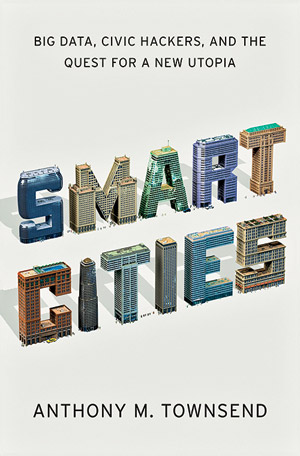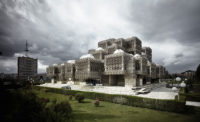Brave New World
Anthony Townsend started thinking about the intersection of technology and cities before the rest of us knew such a place existed. Back in 2002, when carrying a telephone in your pocket still felt slightly cutting-edge, Townsend, with the volunteer labor of civic hackers and donated equipment, was helping to blanket New York City's Bryant Park with 10 acres of free wireless Internet.

Today, Townsend is a research director at the Institute for the Future and a fellow at NYU's Rudin Center for Transportation, and the rest of us have caught up. “Smart cities” is a hot topic, and with good reason. Cities are awash in data. Our gadgets have grown incredibly small and cheap. Not only might a city tree be equipped with a sensor that knows when it needs watering, but it might connect to a software system that checks a summer concert schedule and beams a work order to a Parks Department truck.
Smart Cities is an often exhilarating romp through what is possible, from networked traffic signals that can be adjusted from afar to electric grids that respond to usage; from the location-aware Foursquare app to mashing up restaurant reviews with health-inspection data. It's so full a tour that you can get a long way through it before realizing that something is missing: people. There aren't many of them in Townsend's book, which means there is little consideration of why, exactly, people might want to live in the new digital city.
Townsend is savvy enough to know that, until now, the “smart city” conversation has been driven largely by companies like IBM and Cisco. You can hardly make it through an airport without seeing ads from the former saying things like, “In Singapore, smarter traffic systems can predict congestion with 90 percent accuracy.” Efficiency has become the wired city's selling point. It's easy to measure, but it dodges messy questions about the wonderful complexities of city living.
“People are building smart cities much as we built the Web,” writes Townsend, meaning bit by bit and bottom-up. But elsewhere he wonders, “How could a fully automated city respond to weather automatically as a system?” You needn't be an extreme individualist to contemplate the upside of being able to open your own window willy-nilly.
Midway through the book, Townsend describes a telling moment when he asked Red Burns, the director of NYU's Interactive Telecommunications Program (ground zero for the exploration of networked urban living) to predict what cities will look like after this stage of haphazard experimentation. Burns shrugged and said, “This is the time for people to throw their hats in the air and think.” Townsend, to his credit, says that he'd hoped for “a more concrete vision” of the future of the digital city. It's also to his credit that his book makes readers hope for one too.




Post a comment to this article
Report Abusive Comment